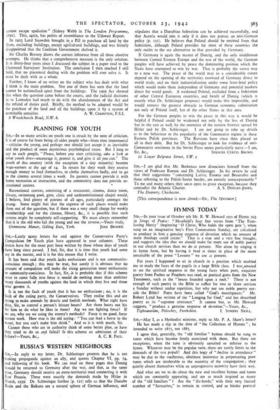THE LAND AND RECONSTRUCTION
Snt,—The land problem seems insoluble. It is nearly a century since John Stuart Mill well explained the nature of unearned increment and suggested that it should be subjected to taxation. Indeed, broadly speak- ing, the Increment Value Duty of two was based upon his suggestions. Why did it fail? There were several reasons. It failed (I) because the proportion of increment to be taken by the State was only 2o per, cent. It should certainly have been at least 75 per cent.; (2) because it was said that increment attached to building as well as to land, an argument difficult to rebut ; (3) because it was levied only at intervals of deaths or sales, whereas it should have been levied at regular intervals (as the Uthwatt Committee propose).
In 1891 Mr. R. B. Haldane, Q.C., MP. (later Viscount Haldane), lent " his high legal authority to a Bill for enabling County Councils to value lands today, and retain the option of purchasing them at a future time at a 'pride from which. every fragment of unearned increment shall be excluded, but which shall be increased by the value of any improvements subsequently made by the owner. All these measures are but steps towards the municipal ownership of the soil, without which a great city
cannot escape spoliation" (Sidney Webb in The London Programme, 1891). This, again, has points of resemblance to the Uthwatt Report.
In 1923 Lord Snowden brought in a Pill to purchase all land by the State, excluding buildings, except agriCultural buildings, and was bitterly disappointed that the Coalition Government shelved it.
Sir Charles Bressey draws the correct inference from all these abortive attempts. He thinks that a comprehensive measure is the only solution. It is thirty-four years since I discussed the subject in a paper read to the Chartered Surveyors' Institution. The conclusion I then reached I still hold, that no piecemeal dealing with the problem will ever solve it. It must be dealt with as a whole.
Further, I know of no writer on the subject who has dealt with what I think is the main problem. Not one of them has seen that the land cannot be nationalised apart from the buildings. The 1909 Act showed this when the question came before the courts, and the judicial decisions in re Lumsden had much to do with the abandonment of the Act and the refund of duties paid. Briefly, the method to be adopted would be the purchase of the land and all the buildings upon it by a system of



























 Previous page
Previous page